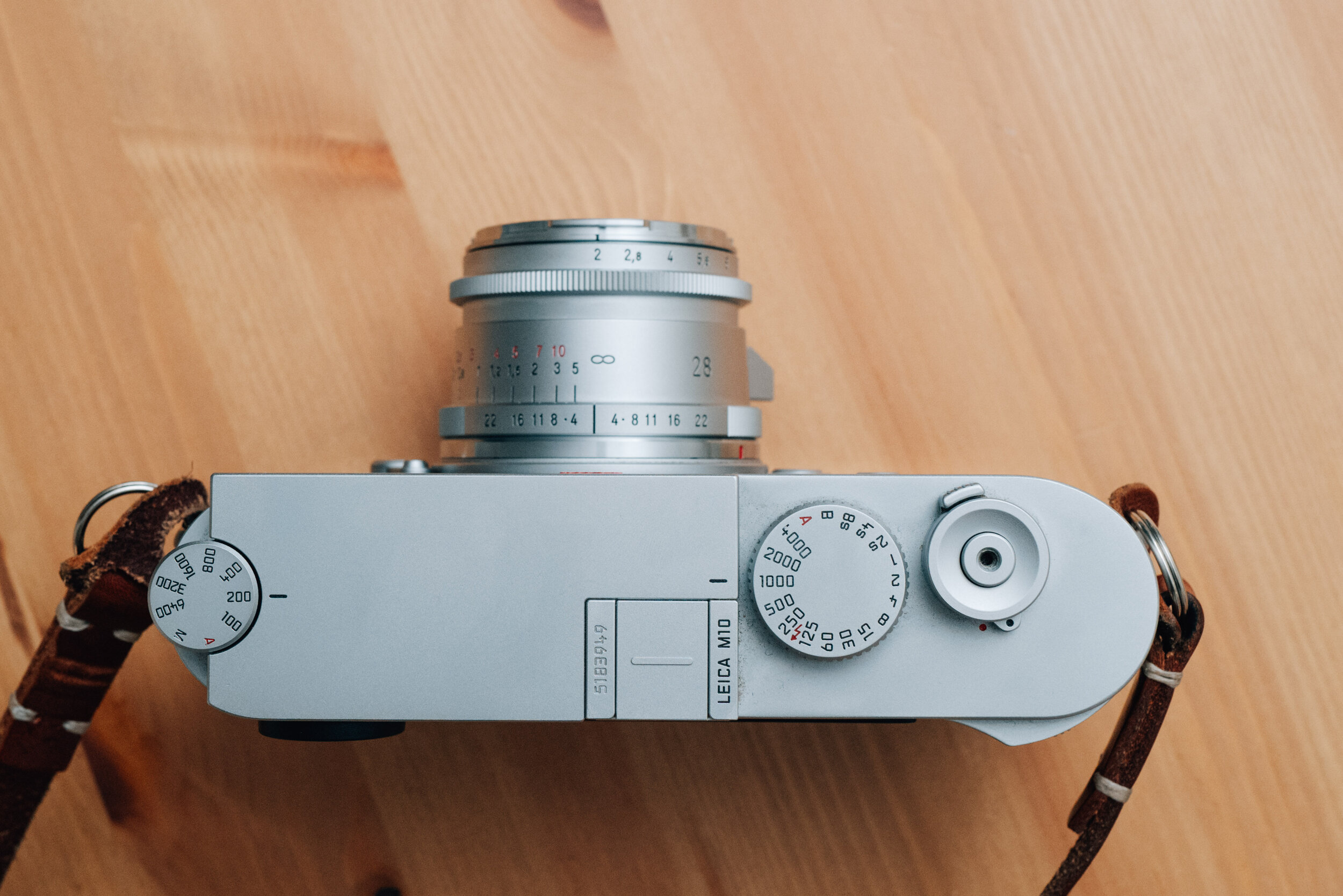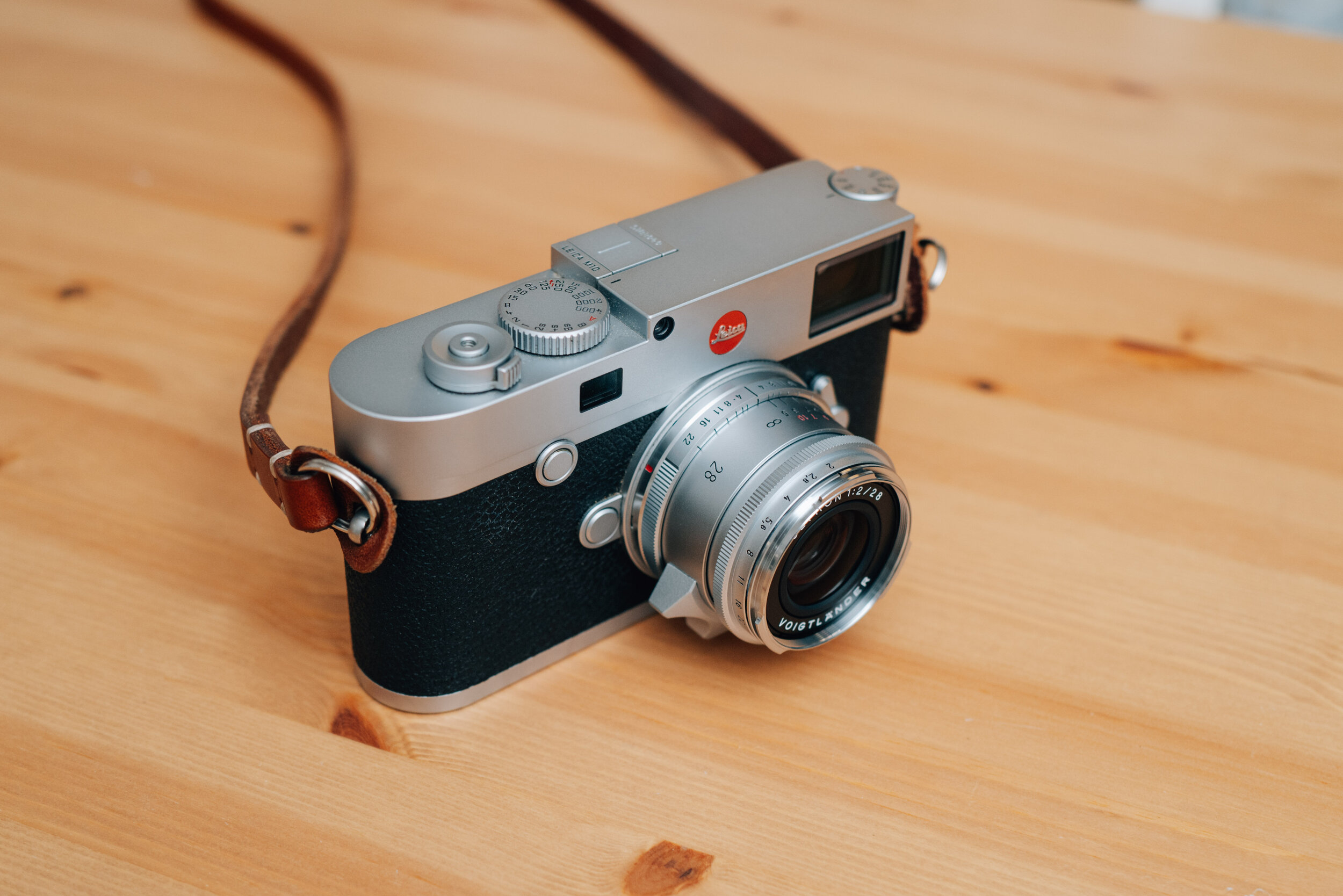Updated April 2025
Introduction
Voigtlander has been drastically expanding its lineup of 28mm lenses. Not too long ago, Voigtlander had only a single 28mm lens (the original 28mm f/2 Ultron) whereas Leica had a complete lineup including the 28 Elmarit, 28 Summicron, and 28 Summilux. In the span of just a few years, Voigtlander has released a competitor for each of these, starting with a new 28mm f/2 lens, which is distinguished from the previous 28/2 Ultron by having an aspherical element and having the word “vintage” in its name.
The new Voigtlander 28/2 is advertised as being sharper, smaller, and lighter than its pre-ASPH predecessor, which had mediocre image quality at f/2. The important question for me upon hearing about this lens is: how does it compare to the Leica 28 Summicron? The 28 Summicron is a well-loved lens thanks to its near-perfect sharpness at f/2, ideal size and handling, and beautiful rendering. If this new Voigtlander 28 performs similarly despite costing a mere $899, it could be a game-changing addition to the list of 28mm options.
Voigtlander 28/2 @f/2, Leica M10
Voigtlander 28/2 @f/8, Leica M10
Voigtlander 28/2 @f/8, Leica M10
About this lens
This lens is called the Voigtlander 28mm f/2 Ultron Vintage Aspherical VM (not to be confused with the original Voigtlander 28mm f/2 Ultron) and comes in three varieties: Type I (black anodized aluminum with chrome accents), Type II (black paint on brass), and Type II (silver chrome brass). The Type II models are styled slightly differently and have a focus tab, whereas Type I has a removable lever. Being made of brass, the Type II models are also noticeably heavier. Other than weight and appearance, these versions all function the same and all focus to 0.5m.
Build quality and mechanics
Build quality is all-metal and at least as good as Leica. The version II feels especially luxurious since it’s made of brass and even has a metal focus tab (Leica focus tabs are plastic). Also, the back of the lens uses a refined, clean-looking design that doesn’t expose the greasy focusing helicoids to the environment. The only criticism I can make is that if you want to use a hood, it attaches with a bayonet mechanism which isn’t quite as nice as Leica’s screw-on hoods.
The feel of the lens is excellent. My copy’s focus tab moves smoothly throughout the focusing range, and the aperture ring feels very high-end.
Size and handling
The Voigtlander 28/2 is nicely compact and balances very well on an M body. In fact, I believe this is the smallest full-frame 28mm f/2 lens ever produced (unless you count the MS Optics 28/2).
From left: Leica 35mm f/1.4 Summilux FLE, Voigtlander 28mm f/2 ASPH, Voigtlander 50mm f/2 APO
I don’t have a Leica 28 Summicron to put side-by-side, but I made an overlay of two images that allows us to directly compare the size of these two lenses. Conclusion: they’re almost the same, but the Voigtlander is a tad smaller. The Summicron in this comparison is the V1 but the V2/V3 are almost identical in size.
 Leica
Leica
 Voigtlander
Voigtlander
Viewfinder blockage
There is very minimal viewfinder blockage; it doesn’t get much better than this for a 28mm lens.
Infinity, Leica M10
0.7m, Leica M10
On the topic of the viewfinder, people who wear glasses may find the 28mm framelines very difficult to see on a digital M camera. If this is the case for you, one option is to get an external 28mm viewfinder such as this one from Voigtlander:
You can also use liveview for precise compositions. I would love for Leica to start offering a 0.58x viewfinder on digital M cameras, but this seems pretty unlikely.
Minimum focus distance
This lens focuses down to 0.5m which adds a lot of flexibility on cameras with liveview. For comparison, version 1 and 2 of the Leica 28 Summicron are limited to 0.7m, but the version 3 can focus to 0.4m.
Here’s a side-by-side of what 0.5m and 0.7m look like at 28mm:
Voigtlander 28/2 @f/2, 0.7m, Leica M10
Voigtlander 28/2 @f/2, 0.5m, Leica M10
And here’s a sample with the Voigtlander at 0.5m:
Voigtlander 28/2 @f/2, 0.5m, Leica M10
As you can see, even 0.5m is somewhat limiting on a 28mm lens, so I’m glad I no longer have the 0.7m limitation from when I owned the Leica 28 Summicron V1.
0.5m focusing on a 28mm lens also allows for some decent selfies:
Voigtlander 28/2, Leica M10-R
Image quality
Distortion:
There is a tiny hint of barrel distortion, but not enough to be noticeable to me. Conveniently, the Leica 28 Summicron has the same exact distortion. This means if you shoot with the Voigtlander using the Leica 28 Summicron in-camera profile, everything will work seamlessly in Lightroom, including vignetting correction, distortion correction, and lens metadata. For this reason I definitely recommend buying a 6-bit coding kit and some black paint to code the Voigtlander 28 Ultron as the 28 Summicron.
Uncorrected
Lightroom correction
Vignetting:
Without profile correction, vignetting at f/2 is somewhat strong. As mentioned above, using the Leica 28 Summicron profile is a convenient solution for this.
Bokeh:
Out-of-focus areas render nicely with the Voigtlander 28/2 ASPH. The shallow depth of field at f/2 combined with the 28mm perspective creates a look that I adore. Background bokeh occasionally has some slight “soap-bubble” appearance but is generally very smooth. Transition zones look clean as well.
Other reviewers have pointed out that this lens has a high degree of optical vignetting (also called “cat’s-eye bokeh”) which is when bokeh circles in the periphery are more elliptical* at wide apertures. I definitely can see this in some photos but I don’t find it significantly bothersome.
*Technically, the shape is the overlap of two circles called the vesica piscis, not an ellipse.
Voigtlander 28/2 @f/2, Leica M10
Voigtlander 28/2 @f/2, Leica M10
Voigtlander 28/2 @f/2, Leica M10
Voigtlander 28/2 @f/2, Leica M10
Voigtlander 28/2 @f/2, Leica M10
Die-hard Leica fans might perseverate on this question: is the rendering of this Voigtlander lens as good as the 28 Summicron’s? To answer that question, here are some unlabeled pictures. Four were taken at f/2 with the Voigtlander, and three were taken at f/2 with the Summicron:
Unless you can clearly tell which is which, I think it’s fair to say the difference is not significant. (Contact me if you think you know, and I’ll tell you if you’re right!)
Longitudinal chromatic aberration:
This is not an apochromatic lens and some green/purple spherochromatism is present, but it’s minor enough that I don’t think I’ll ever be bothered by it.
Lateral chromatic aberration:
This is already a non-issue on digital since Lightroom automatically corrects for lateral CA, but I see absolutely none even with correction turned off.
Sharpness, infinity:
Overview
Center, f/2
Center, f/4
Mid-frame, f/2
Mid-frame f/4
Edge, f/2
Edge, f/4
Corner, f/2
Corner, f/4
Analysis: The Voigtlander 28/2 delivers incredible corner-to-corner performance even at f/2. Close inspection shows a tiny improvement at f/4, but f/2 is already good enough for landscapes.
Sharpness, 1.5m:
Overview
Center, f/2
Center, f/4
Mid-frame, f/2
Mid-frame, f/4
Corner, f/2
Corner, f/4
Analysis: Basically the same performance as infinity. The Voigtlander 28/2 is sharp even in the extreme corner at f/2. There is some improvement in the mid-frame and corners at f/4 but f/2 is already plenty sharp for me.
Sharpness, 0.5m:
Overview
Center, f/2
Center, f/4
Analysis: Center performance at 0.5m is excellent even at f/2. I also detect no focus shift whatsoever; in contrast, the 28 Summicron suffers from this a little bit.
Since this lens performs so remarkably, I decided to put it through a torture test: extreme corner sharpness at minimum distance, wide-open. I’ve only ever done this test with the APO-Lanthar lenses.
Overview
Corner, f/2
In contrast to the APO-Lanthar lenses, the 28/2 does show a small amount of softness in this test, but it’s comical how far we had to push it to show even the slightest degradation.
Summary and recommendations
Voigtlander 28/2 @f/2, Leica M10
Voigtlander 28/2 @f/2, Leica M10-R
When I saw the announcement for this lens, I expected similar performance to the Voigtlander 35/2 Ultron (review), which is a great lens but wouldn’t be mistaken for an APO lens. Shockingly, the new Voigtlander 28/2 is one of the highest-performance 28mm lenses ever made. It’s honestly a bit comical that it’s offered with 1950s styling, but optically matches or exceeds the $5,395 Leica 28 Summicron.
My recommendation is therefore very simple: if you are looking for a 28mm f/2 lens, get the Ultron. The only justification I can come up with to buy the far more expensive Leica 28 Summicron (review) is if you really want the version 3 Summicron for its 0.4m focusing and built-in extendable hood. But even then it’s questionable, as the Voigtlander is smaller than the Leica and still focuses down to 0.5m.
There are a few other compelling alternatives to the Ultron. The upcoming Voigtlander 28/2 APO-Lanthar is supposed to be incredibly well-corrected with the drawback of being somewhat larger and more expensive than the Ultron. It’s hard to see why one would need even higher image quality than the Ultron, but I will wait to test this lens before drawing conclusions. The Voigtlander 28/2.8 Color-Skopar is also a well-regarded lens for those who don’t need f/2; I personally am not willing to give up that much depth of field control. Finally, for anyone who wants a 28mm lens faster than f/2, there’s the Voigtlander 28/1.5 Nokton (review). I had a frustrating experience with quality control issues, but otherwise this is an excellent 28/1.5 lens that’s not that much bigger than the Ultron.
I ended up selling my Voigtlander 28/2 Ultron for various reasons, including to test out the 28 Nokton. I’ve now come to miss this lens and will likely repurchase it in the near future, unless the upcoming APO-Lanthar wins me over.
Good
Image quality
Build quality
Size and feel
Price
0.5m focus distance
Bad
None
Buy here
Making this website is my hobby and hosting it costs $200/year. If you decide to buy this lens and want me to get paid a commission, please complete your purchase using one of these links. Alternatively, you can buy something from my accessories page or buy me a coffee!
Other alternatives (not recommended)
Zeiss 28/2.8 Biogon
Leica 28/2.8 Elmarit ASPH
These lenses aren’t bad but they’re more expensive than the Voigtlander 28/2 despite being one stop slower and having worse performance.
Leica 28mm f/1.4 Summilux ASPH
I hear this lens is a great performer, but I will probably never own one since it retails for the astronomical price of $7,995. It’s also larger than the similarly-performing Voigtlander 28/1.5 Nokton and limited to 0.7m focusing.
Voigtlander Ultron 28mm f/2 (pre-ASPH)
I’ve never used this lens. Although it offers an f/2 aperture and a very reasonable price, by all accounts it has significantly compromised image quality including very blurry edges at f/2.
Additional reading
Fred Miranda’s review
BastianK’s review
Comparison vs 28 Summicron V2 by Fred Miranda
Comparison vs 28 Summicron V2 by Benj Haisch
More sample photos
Voigtlander 28/2, Leica M10-R
Voigtlander 28/2, Leica M10-R
Voigtlander 28/2 @f/2, Leica M10
Voigtlander 28/2 @f/8, Leica M10
Voigtlander 28/2 @f/2, Leica M10
Voigtlander 28/2 @f/5.6, Leica M10
Voigtlander 28/2 @f/8, Leica M10
Voigtlander 28/2 @f/11, Leica M10






